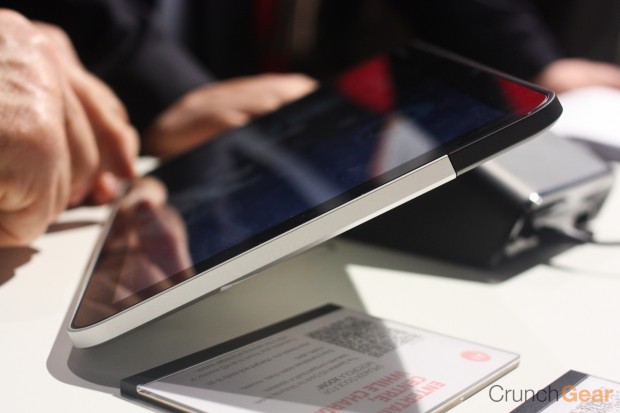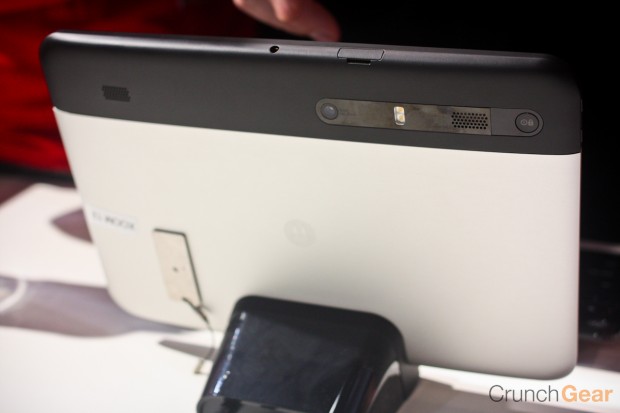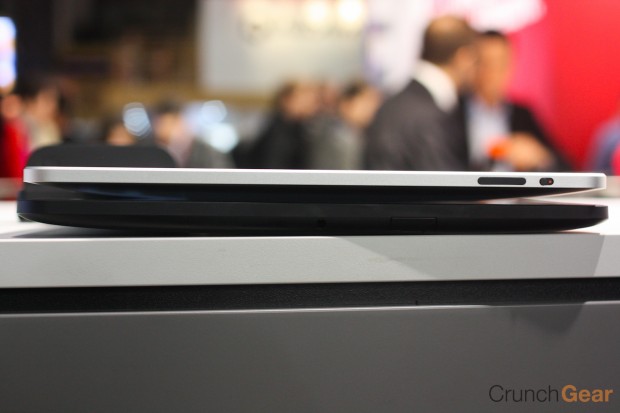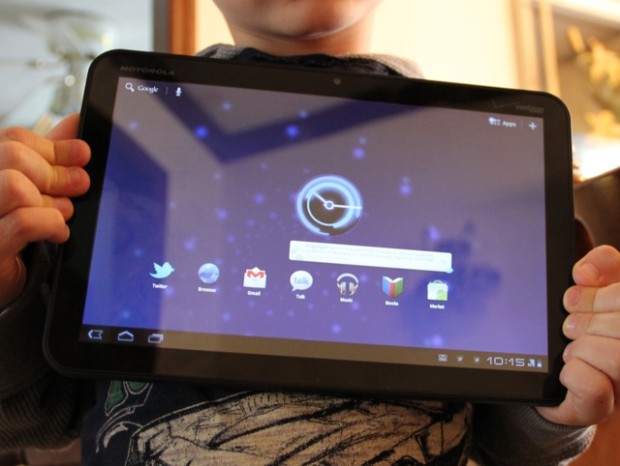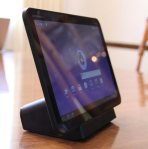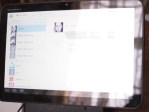
Short Version
Few tablets have met with such widespread anticipation as the recently-announced Xoom. It is the closest anyone has come to an iPad equivalent for the Android set. I was impressed with the speed, design, and quality of the device, and although there are a few caveats, I came away optimistic for the new crop of Honeycomb devices that will follow this one.
Features:
- Verizon 4G Connectivity
- 10.1-inch, 1280×800 screen
- Android 3.0 Honeycomb
- 1GHz Dual Core Tegra 2 Processor, 32GB internal storage, MicroSD support
- $600 with two-year contract/$20/month for 1GB usage
Pros:
- As small as the iPad
- Lightning Fast
- Nice screen
Cons:
- Wonky media playback, tethering/mass storage via USB
- Honeycomb improvements are somewhat limited
- Verizon pricing/Wi-Fi requirement is crazy
Body
At first glance, the Xoom is a featureless slab. It comes in black or silver; the 4G version for Verizon is the most US-relevant, but the silver Wi-Fi only version will surely have a presence here as well. The 4G version we reviewed is clad on the back in a sort of rubberized metal and the only ports are a mini-HDMI, micro USB, and a small dual-pin dock connector. The device cannot be powered via USB, instead depending on a Xoom-specific charger. Dual speakers flank the 5-megapixel camera and LED flash combo and there is an almost impossible-to-find power button next to the camera, an odd design choice. The only other physical features are a dual rocker for volume and a small slot for a microSD card that is apparently currently unsupported.
The size and shape are strikingly similar to the iPad’s. It is a bit wider and very slightly thinner, although it was oftentimes mistaken by others for Cupertino’s juggernaut. There are two LEDs, one that signals emails and the like on the right side and a small red light that switches on when using the front camera.
There is no removable battery. The back panel looks like it could be removed but it holds the screen in place, thus preventing further exploration without voiding the warranty.
In all, the Xoom is an impressive piece of kit. It doesn’t feel as “hollow” as the iPad, perhaps because of the Xoom’s 1.6 lb weight versus the iPad’s 1.4.
Processor
I was amazed by the Xoom’s dual-core Tegra 2 processor. It is lightning fast and most activities took seconds. It beat the iPad in side-by-side website scrolling tests in many cases. Now for the bad news: if you open too many apps, it slows down to a crawl. The horrors that Apple seems to have avoided in iOS are readily apparent here. I had quite a few app crashes and many apps designed for 2.x devices crashed. Google Body, remade for Honeycomb, crashed every other try.
So the good part is that the Xoom is truly a fast machine. The bad part is that this speed is quite fragile. If you are vigilant, you can maintain this speed by selectively closing apps, but the results are often frustrating. We saw this effect in early Android builds as well, and chances are it will be sped up significantly by 3.1 and 3.5. Until then, however, memory management and crashes will be part of your Honeycomb experience.
Screen
The screen is the real draw on this device. The glossy 10-incher is wonderfully responsive and 1280×800 resolution allows for a great deal of living detail in the interface, icons, and during media playback. Strangely, the resolution didn’t play well with some photos, including photos taken with the Xoom’s own camera; they appeared fuzzy when you’d expect sharpness. I was slightly disappointed at the sample images included with the device but the resolution in the music player and on the UI in general adds considerable crispness to the text and icons on screen.
Again, there’s bad news: this thing is amazingly susceptible to fingerprints. The front and the back of the device were a mess after the first few minutes. You will definitely notice an entire jungle of finger tracings and taps if you use the Xoom for any period of time. To be fair, the iPad has this problem too, at least on the front, but it’s worth noting that the Xoom doesn’t improve on it here.
It is almost impossible to take photos of the screen, so please excuse some of my more onerously bad shots. For clearer UI shots, direct captures of the Honeycomb UI have been making the rounds for months.
Speakers
The speakers are acceptable but are situated on the back of the device so you don’t get much forward throw. You can mute the speakers with your hand if you’re not careful. The optional media dock adds a bit more volume and quality to the audio, if you’re inclined to use this as your out-loud media device. Headphone playback was on par with any other PMP.
Camera
The camera is on par with any other 5-megapixel concoction and the flash adds a sufficient amount of coloration to dark scenes. The front camera is also fine. You can’t really expect too much from tiny cameras like this, and unlike an iPhone 4 it’s not designed to be a point-and-shoot replacement.
Google Video Chat worked quite well, although the “shake reduction” feature was more a gimmick that ensured that the central image was in focus and still while the background was severely truncated. If you set it on high, you get an image like the one above. It’s kind of goofy but in terms of video chat on a mobile device it’s usually handy.
Here are some sample images:
Front Camera
Rear 5-megapixel Camera (Click to Embiggen)

Battery
Battery life is about 18-20 hours on one charge although your mileage may vary. I was able to listen to a few hours of music, read a book, and browse the web for most of the day and it dropped to about 67% after 10 hours. I couldn’t test video playback due to some problems in format availability, but it’s safe to say your battery life will shrink with more processor-intensive tasks. But using web, music, email, and a little light gaming, the device lasted quite a while.
Again, software optimizations in future Android versions may improve this, as they have in the past, but battery life is quite solid as it is.
Accessories
The Xoom has two docks, a standard, smaller one and a larger one with a built-in speaker. It supports Motorola’s Bluetooth keyboard and standard Bluetooth headsets. The keyboard includes keys for home and the pull-down menus, which improves usability considerably.
One problem everyone who used this device faced was trying to seat it in the entertainment dock. The two bottom ports were very hard to connect to the corresponding jacks and even with a handy little dot on the bottom of the device and another dot on the dock for lining things up it was quite difficult. A single, wide dock port would have been preferable.
There is also a slick Bluetooth keyboard that functions as you would expect.
Wi-Fi/Wireless
I had some trouble connecting to even strong Wi-Fi connections with this device. For some reason my home network crapped out at two bars almost constantly, and I had much better luck getting a Verizon data connection than depending on Wi-Fi. This could potentially eat into your $20/month 1GB plan. With limited data it’s hard to say whether this is a problem just with my circumstances or if it’s a Xoom-wide issue.
Soul
I shot a very brief video walkthrough of the interface, below. If you’re familiar with Android, Honeycomb isn’t radically different. It is, however, definitely suited for large screens. Rather than the cramped feel of previous Android versions, the vistas are wide and expansive.
http://player.ooyala.com/player.swf?embedCode=NjanUxMjrX1BX1ypX_LDLkvERMvhxbN1&version=2
Interface
The Xoom is an Android tablet, not an overgrown phone. The UI is striking and the use of screen real estate is excellent. Even the unlock process, activated by sliding a little padlock out of a circle, seems to invite you to revel in the screen size. The onscreen keyboard is quite usable with one hand or two. The default screen displays a few frequently used apps including mail, music, and books. There is also a unique video editor with a real jog wheel for scrolling through video. In short, Google has really pushed Honeycomb to the next level in terms of tablet interaction. Apps take up the full widescreen real estate, making programs like Google Body or the Pulse Newsreader far superior to their previous versions.

Are there some bumps on the road? Sure. Some of the features are a bit gimmicky, including an odd 3D effect that occurs when you move the device in the Gallery app. Viewed head-on the images look flat but turning the device sideways shows that they sit on a stack of nearly indiscernible cards. It’s a cute trick, but unnecessary.
The other problem occurs when you run earlier Android apps. Twitter seems to look and work fine but games like truly execrable Super Android Brothers, a SMB clone, looked over-aliased and grainy. Like iPhone apps run on the iPad, the results are not excellent.
The home screen is the most unique aspect of Honeycomb and the one you’ll notice first. The widgets and apps, thanks to the large, high-res screen, can be placed anywhere on the screen. When the screens are empty, in fact, the entire interface seems quite empty, a blank canvas.
UI sensitivity is quite snappy and you’re apple to switch back to home thanks to a set of buttons in the lower left corner. The back button and home button is always visible and an app switch appears in some cases. You access your entire app library from the home screen by pressing a button on the top right corner and the notifications, as is Android’s wont, are excellent and unobtrusive.
Thanks to the Tegra 2 processor, long lists of emails, Tweets, and the like scroll with a surprising speed, especially if you’ve used previous Android tablets.
The kit also includes Google Maps, Latitude, and Navigation and includes A-GPS support for these apps. The device is a bit big for navigation, although Google Maps is a great way to plan a route through a strange city while sitting in a Seine-side cafe.
This version of Honeycomb does not support Flash. The Xoom will support Flash in a few months, which is kind of hilarious seeing as that was one of Motorola’s original selling points. Regardless, you probably won’t miss it.
Media Playback
The Xoom offered a very frustrating media playback experience. While the music I placed on the device played back without a hitch, the video refused to play. I uploaded a few AVIs of various sizes, including some that worked on previous versions of Android. I was unable to solve the problem with Motorola but I’ll keep trying. Formats and codecs are difficult, and while Apple’s restrictive re-encoding and resolution limitations are inconvenient, at least it’s easy for the end user to simply say “okay, make this play on my device.” It’s more difficult on Honeycomb, but that will probably smooth out with time.
Business
In terms of business usability, the Xoom is great for basic functions like email, PIM, and some text editing. There are very few apps on board, though you can access QuickOffice in the Marketplace. The email client is very robust and usable, however, and the contact and calendar apps are too, if a bit flashy. They sync with Google Apps.

The Good
The Xoom is a great tablet. If you’ve been waiting for an Android equivalent to the iPad, this is will probably satisfy you. The speed of the processor, the beautiful screen, the non-nonsense design, and usability make it a winner.
If you and I were sitting at a bar and talking about tablets, I’d say this and the iPad were the two to look into right now. That will change once other manufacturers start shipping, but this device is a complete, dedicated device for media intake and web surfing.
The Bad
The pricing of this thing, $600 with two year contract or $800 without, is a bit tough to swallow considering the total cost of ownership over two years, although the higher price is partially justified by specs that are truly superior to the iPad’s.
There are going to be plenty of Honeycomb fish in the sea pretty soon, friends, and the Xoom is but a bit player in Android’s steady march towards world domination. What does that mean for dedicated Androidites? Well, you have to decide: do you like Motorola and Verizon or would you prefer to wait for any of the future Honeycomb devices slated to drop in the next few months? The Galaxy Tab 10.1 in particular shares almost all of the Xoom’s specs.
The Xoom also isn’t yet for business users. I’d be concerned about Flash support as well as potential app incompatibility or instability.
Bottom Line
I asked some users about their thoughts on the Xoom and found a number of folks who were very excited by the device. I, personally, think it’s a great leap forward for Android on the tablet and makes devices like the Android 2.2 Galaxy Tab look like antediluvian technology.
Again, this is the first of many 3.x tablets to visit their reigns of glory upon us. Is it – or will it be – the best Honeycomb tablet out there? I doubt it, but Motorola has offered a strong showing out of the gate and I was very impressed at the build quality and attention to detail, at least when it came to UI and physical design. The odd ports on the bottom are a bit of a concern, but otherwise the device is quite capable.
If you literally can’t wait, this is a great tablet for you. But a few months may bring changes to the Honeycomb market that will make it less of a coup and more of an also-ran.
Video music by FluidVolt.
